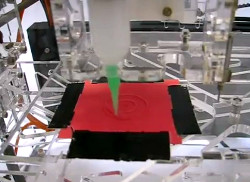Chemists from the University of Glasgow make laboratory glassware using sanitary silicone and a 3D printer
 Manufacturing laboratory glassware on individual projects is an expensive and long business. Professor Leroy Cronin and his staff were able to make this process much faster and cheaper using an inexpensive fab @ home 3D printer and ordinary sanitary silicone. The utensils printed out in this way not only exactly meet the requirements for a particular reaction, without any compromises or restrictions associated with the use of standard glassware, but may also include electrodes and catalysts imprinted directly into the walls of the vessel.
Manufacturing laboratory glassware on individual projects is an expensive and long business. Professor Leroy Cronin and his staff were able to make this process much faster and cheaper using an inexpensive fab @ home 3D printer and ordinary sanitary silicone. The utensils printed out in this way not only exactly meet the requirements for a particular reaction, without any compromises or restrictions associated with the use of standard glassware, but may also include electrodes and catalysts imprinted directly into the walls of the vessel.By mixing silicone with carbon powder or with catalysts, the scientists were able to create an “active” laboratory glassware, some parts of which conduct electricity and influence the course of the reaction. In addition, by programming the pauses in the printer, you can add to the design of any other parts - glass windows for observation, adapters for docking with standard equipment.
Now researchers are looking for new materials for printing, allowing to expand the range of working temperatures and reagents with which it will be possible to work on printed equipment.
Source - Nature.com
')
Source: https://habr.com/ru/post/146384/
All Articles